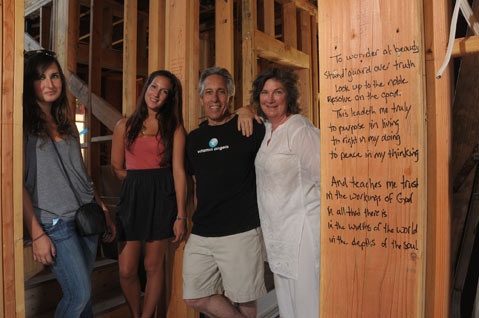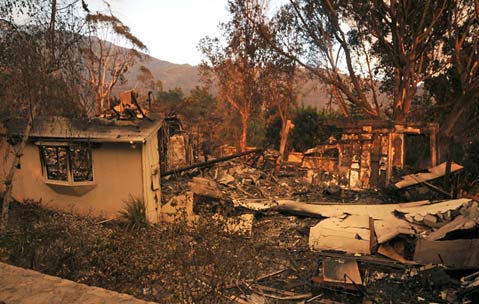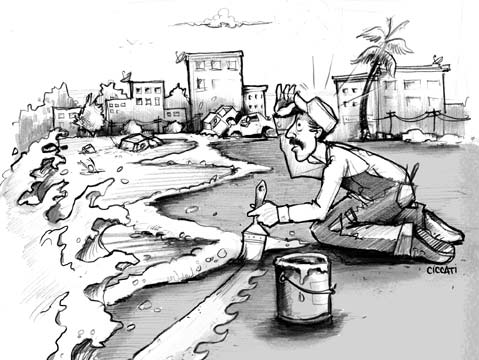Mission Canyon Dreaming
Two years after the Jesusita Fire Sam Kornell Looks at the Idyllic Past and to the Global Future of Fire, Flood and Drought

For Zoe Schiffer, growing up in Mission Canyon was a child’s equivalent of la dolce vita — the sweet life. Born in 1992 to Kim and Howard Schiffer, Zoe is dark and pretty, a vegan with a quick wit who is majoring in creative writing at Seattle University, where she is a freshman. With her older brother and younger sister, she spent her childhood in a modest home situated at the end of Tunnel Road, near the entrance to the Seven Falls trail. Chickens and turkeys roamed her backyard, maneuvering between a compost pile and a set of avocado trees that together conspired to keep her yellow lab Artemis incorrigibly fat.
Zoe’s father runs an international charity called Vitamin Angels. Her mother, a chef, is one of Santa Barbara’s first “slow food” proponents. By the time Zoe was born, the two were no longer hippies, but they still maintained a progressive spirit born in that era. Zoe guesses that she spent at least a quarter of her childhood shoeless, and when they weren’t reading, she and her siblings were outside, making lizard-catchers in their backyard or prowling through the densely unkempt canyons and ridges around their home.
“Growing up in Mission Canyon preserved my innocence for a long time,” Zoe told me recently during a break from school. It was a clear morning, and we were at the French Press, a coffee shop near the yoga studio where she takes classes. Sipping an Americano, she recalled her childhood fondly. “I had a lot of freedom. We didn’t have a TV, so we really had to make everything up — we had to create our own fun.” For years, Zoe said, she and a girlfriend a ridgeline away would meet at their fence lines and carry on shouted conversations across the canyon floor.
Idylls, of course, appear eternal — that is partly what makes them idyllic. But even idylls end. A little before 2 in the afternoon on May 5, 2009, a spark from a power tool started a fire near a trail in the back country not far from Tunnel Road. The resulting conflagration — which we now know as the Jesusita Fire — consumed nearly 80 homes, among them the Schiffer family’s. But when I asked Zoe if she could envision herself one day returning to live in Santa Barbara — fire risk and all — she nodded affirmatively.
Take a moment, however, for a thought experiment: What if somehow real estate prices in Santa Barbara miraculously dropped and a creative writing major could afford to buy a house in the same beautiful canyon in which she was raised? Zoe would have to take into account something that her parents never had to think about — global warming. Even I, who frequently write about climate change, nevertheless spend a considerable amount of time not thinking about it. I was born and raised in Santa Barbara, and when I consider whether I’d like to raise a family here — which is to say when I brood about how to afford to raise a family here — I scarcely ever take into account the probability that the future will not be like the present. “I don’t think I can be the only person who finds in myself a strong degree of psychological resistance to the whole subject of climate change,” the British journalist John Lanchester has written. “I just don’t want to think about it.”

The Greening of Gas
Today, there is more greenhouse gas in the atmosphere than at any time in at least the past 15 million years, and climate modelers believe that within as little as two decades, the band of heat currently expanding northward and southward from the Earth’s equator could result in climate conditions in Southern California similar to present-day Northern Mexico. The Zaca, Gap, Tea and Jesusita fires, which came one after another in harrowing succession, are emblems of a larger process. The physical beauty and the temperate Mediterranean climate that infuses nearly every angle of the South Coast may, in coming decades, be ending. Scientists generally agree that fires like the one that burned down Zoe’s home will become more common, as will the drought that gives rise to them, as will the floods that follow.
Vividly etched in the memory of any longtime Santa Barbaran is the night of January 11, 1995, when torrential rain fell on the South Coast, causing the clay topsoil of the mountains and hills that cradle the city to grow heavy with water and then fluidly come apart, breaking and flooding downward. “State Street, known for its quaint shops, looked like a river bottom,” reported the L.A. Times. “Two unoccupied cars were completely buried in mud that filled the Mission Street underpass.” Together, the flooding and mudslides caused millions of dollars in damage.
The storm, at the time referred to as a “once in a century” event, is almost certainly an omen, like the Zaca, Gap, Tea, and Jesusita fires, of Santa Barbara’s future. Together, these things will steadily change what it means to be a resident of Santa Barbara. Climate modeling indicates that major storms are going to beset California more frequently in coming decades, and their damage will be compounded by the likelihood that they will interrupt periods of prolonged drought. Santa Barbarans who remember the flood also remember the seven years of drought that preceded it. For them, visions of desiccated lawns and recycled dishwater are still clear. Climate scientists agree that in coming decades, such droughts are going to come harder and last longer until, as Richard Seager, a scientist at Columbia University, has put it, “You can’t call them droughts anymore.”
Drought interrupted by brief but intense storms — in such circumstances, “The whole ecosystem either dies, gets attacked by insects, or gets hit by fire,” said Ron Neilson, a bioclimatologist with the USDA Forest Service. A recent report by the federal government found that it is “90-95 percent likely” that arid parts of the West, such as Santa Barbara, are going to experience significantly more wildfires in coming decades. “We are in the mega-fire era,” said Ken Fredrick, a spokesperson for the federal government.

In time, many people in high-risk areas — such as Mission Canyon — may no longer be able to get private homeowner’s insurance. Matthew Kahn, a professor at UCLA, said that he wouldn’t blame insurance companies for dropping coverage in places like Santa Barbara. “When Allstate decided to stop writing any new policies for California, wildfire was the number-one thing they cited,” he said. “I don’t fault them for that. How do you responsibly stay in that market if the future’s not like the past?”
During the Tea and Jesusita fires, Oran Young and his wife, Gail Osherenko, were forced to evacuate the condo they share near the Riviera Theatre, at the foot of Mission Canyon. Tall and ruddy, Young is one of the world’s leading experts on the Arctic. He is friendly, speaks carefully, and sticks closely to the most mainstream, uncontroversial scientific literature. If he is a scheming scientist attempting to hoodwink the public, he does an excellent job of hiding it.
Not only is climate change already occurring, Young told me — according to NASA, 2000-2009 was, globally, the hottest decade on record, and 2010 tied as the hottest year on record — it will continue to intensify for at least a century, even if we take the strongest possible measures to halt its progress. He left no doubt that anyone planning to be a resident of Santa Barbara 20 years from now should assume that they will inhabit a place with a different climate than the one they now enjoy.
“It’s not like Santa Barbarans are going to wake up one morning and bang — everything is different,” he said. “But we are going to find our lives progressively affected. If we’re looking at this from a 20-year perspective, we’re going to be seeing these kinds of issues” — intense storms, drought, and wildfire — “step by step becoming more central to our lifestyles.”

Blue Skies and Blue Lines
In April 2009, a controversy erupted over a piece of public art meant to show what would happen to Santa Barbara if climate change caused a large portion of Greenland to melt. The project would have demarcated the rise in sea level with a blue line, painted on the sidewalk and streets threading through the lower East- and Westsides. Shortly before it was set to be permitted, a number of prominent real estate agents convinced the City Council to withdraw support by arguing that real estate values below the line would depreciate were it to actually materialize.
The story of the blue line is telling. Santa Barbara would become uninhabitable because of drought long before glacial melt of that extent could cause a beachhead to form at Anapamu Street. But the real estate agents’ opposition is understandable. A bold line inscribed on pavement that tells an unignorable visual story about climate change would certainly have made an impression on me if I came face-to-face with it one morning on my way to get coffee. As it is, I find global warming and the threat it poses especially easy to ignore when I’m in Santa Barbara. Whenever I return, I’m struck anew by how beautiful it is. Over time, my appreciation of its loveliness seems to deepen as it mingles with the fragments of knowledge I build of the world beyond its borders.
So what are we supposed to do to preserve the idyll Santa Barbarans enjoy each day, and in which Zoe and I grew up? In all the time I’ve been writing about climate change, I can’t remember a single instance in which a climate scientist has told me that it’s time everyone give up hope and accept the inevitability of climate apocalypse. Instead, they invariably emphasize, often with great passion and always with firm persistence, that the single most important fact about climate change is its alterability. It is not too late to reduce greenhouse-gas emissions sufficiently to prevent catastrophic change, they say; we just have to wake up to the threat it poses.
For a time, it seemed as though grassroots action on climate change was a sideshow to a more important project — the effort last year in the U.S. Senate to pass a climate bill. But after millions of dollars spent by environmental groups to lobby politicians, messaging strategies that encouraged senators to “frame” climate change as nothing more than an opportunity to make money on clean energy, and a series of concessions on the bill itself that led many scientists to claim it was too watered down to merit support anyway, it failed.
So where does that leave us? If we’d like to preserve the life we’re accustomed to enjoying here, something global will have to be done to reduce the amount of carbon pollution clogging the atmosphere. It will require a movement consisting of ordinary people who demand that world leaders make laws and sign treaties limiting carbon emissions. That movement may be led by Zoe and her generation.
But climate change is so big that slowing it will require all of our participation. Such participation is possible. History shows that humans are capable of uniting to confront dire threats, and last fall, the environmental group 350.org organized 74,000 events in 188 countries on a single day, the most widespread day of political action the planet has ever seen. Perhaps climate change will not be the canvas upon which the 21st century is painted. But what if the scientists are right and it is? The central question of our time will then be whether we kept our faith with them and the message they’re relaying to us, which is simple: We can save the world from climate catastrophe, but we can’t half-ass it, and we have to start now.
When we spoke at the French Press, Zoe told me a story. One summer evening when she was 9 years old, a donkey appeared on her porch, interrupting dinner. Her father managed to cajole it back to the corral across the street. In return, their grateful neighbors granted Zoe and her siblings access to a private path that wound its way across their property and then down to the canyon floor, where it met a secluded swimming hole hidden by oak trees.
During warm summer afternoons, when the water was cool and clear, Zoe and her sister, Eliana, would cross the street and drop down the path to the swimming hole. For hours, they would swim and play games unsupervised, their only companions the trees and the creek. They liked to encircle the terraces of the swimming hole with dozens of tiny fairy homes, which they constructed carefully from rocks. In the winter, when the rains came, the homes would be washed away, and in the spring, the girls would rebuild.
After the Jesusita Fire, the Schiffers decided to rebuild their home. Together, they designed an elegant Italianate structure with a wood-fired oven and an airy dining room. The house will be finished this summer. They will hang paintings on the walls, and they will fill the shelves with books. The garden will be replanted with fruit trees, vegetables, and flowers. One evening, the family will have a big dinner, and as they eat, the smells of Mission Canyon will drift into their dining room and mingle with the aroma of whatever feast Kim has concocted. After the dishes have been put away and the wineglasses refilled, the Schiffers will commence a fierce game of Boggle while outside a warm evening in paradise proceeds at its usual, languorous pace.



